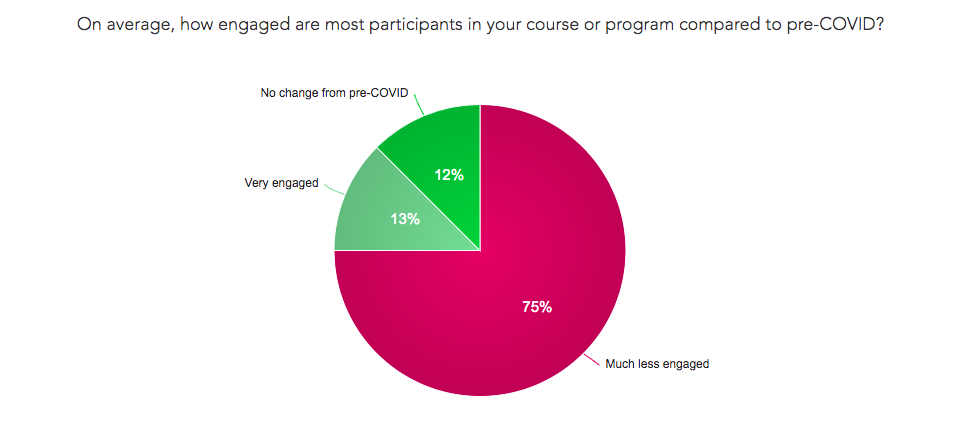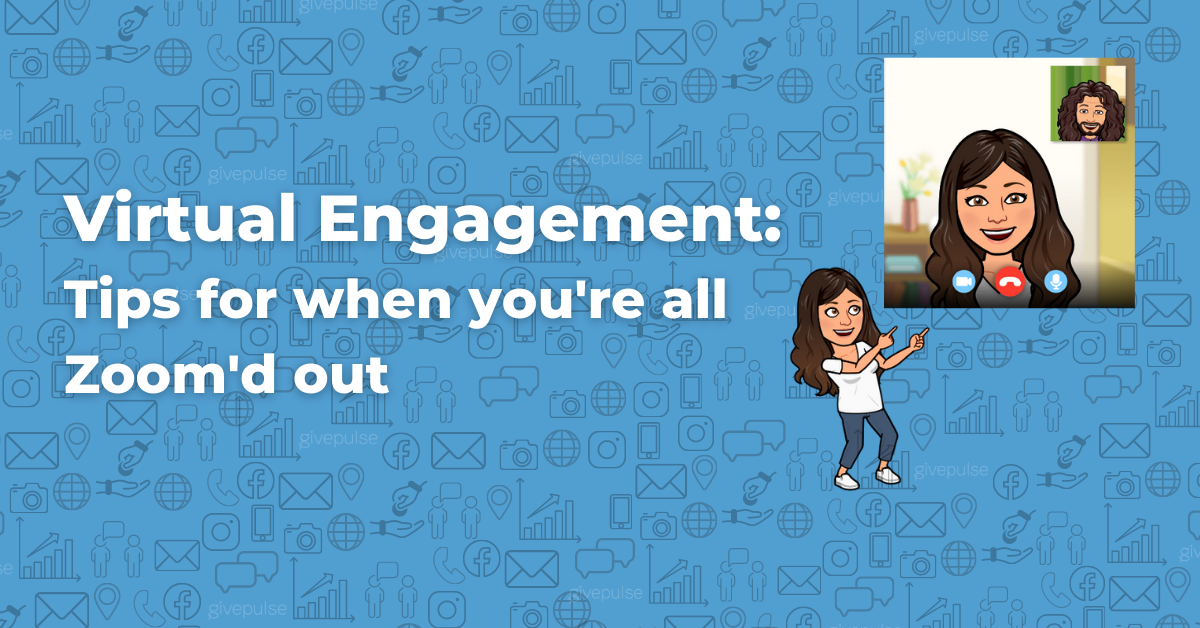In this blog, our first of the new year, we provide a foundation for effective and impactful virtual engagement. Whether you are a program coordinator for a nonprofit, a faculty member for service-learning courses, or a director in community engagement or philanthropy, we hope you will be able to use these tips as you plan programming for 2021!
For Devon, a guest speaker representing the volunteer perspective in our recent virtual engagement webinar, the COVID-19 crisis coincided with changes in her personal life. She started as a first year medical student while facing several of the most intense challenges COVID-19 can offer: family members became sick, and her family was unable to grieve after the untimely passing of her grandmother from the virus.
Although these challenges made it more difficult, Devon knew she wanted to remain fully engaged in her community. “My desire to volunteer is still very much there,” she said, adding that because of her own experience with COVID-19, finding virtual opportunities is of the utmost importance.
This story is indicative of broader challenges facing communities: in our recent partner survey, 94% reported that participants had shared COVID-specific struggles with their organization. Communities are being impacted by this public health crisis, with consequences for productivity, sense of safety, mental health, and more. Perhaps due to these factors, 75% of survey respondents reported that participants were much less engaged than they had been before COVID. Yet participants like Devon want to engage, and to make an impact, despite these setbacks.

On December 10, GivePulse brought together a few of our community partners to form a panel, discussing shared virtual engagement challenges and successes during COVID-19. In this post, we have gathered our nine tips for virtual engagement success to help you approach these challenges with an empathetic mindset while continuing impactful work for your organization or community.
1. Pivot and Rebuild
The first hurdle to virtual engagement is to develop engaging opportunities for your organization or partners. Many of these opportunities may meet a new need stemming from staff or organizational changes, such as fundraising, grant writing, and social media. Others incorporate interactive elements into virtual activities; for example, Devon, now volunteering with the Big Brothers/Big Sisters program, set up a crafting session with her little sister. She delivered supplies for a project to her little sister’s home, and the two were able to work on the project “together” over Zoom. Our full community safety guide includes detailed information about how to develop virtual and remote opportunities that, like Devon’s project, are interactive and flexible.
2. Learn From and Activate Your Network
As we all work to pivot our engagement efforts in a virtual world, lean on your existing network to learn what others have done to maintain community involvement. Lindsey Payne, the Volunteer Coordinator at San Antonio’s The Doseum, recalls reaching out widely in March and April: “We were talking to everybody — what’s working best for you? What’s not working for you?” Your network might include similar nonprofits, peer institutions, local businesses, or even community members such as volunteers, students, or employees. Open virtual feedback sessions or surveys can facilitate communication for new ideas and activities. In addition, attend webinars and virtual conferences, or even form your own online community with peer organizations and institutions. Check in regularly to see what has worked for others, and come together to develop guides that can be shared with others. If you are partnering with organizations in your community, particularly as an institution of higher education, use this network to come up with flexible opportunities, bearing in mind that capacities may have changed due to COVID-19. As we all learn how to work in the new normal, having a strong community to learn alongside is invaluable.
3. Provide Consistent, Relevant, Everyday Opportunities
Realizing that consistent, everyday opportunities were more appealing to his students, Dustin Perry, a teacher and service coordinator at Christian Brothers High School, Memphis, “pivoted” to opportunities such as making and delivering packed lunches, creating homeless care packages that students can keep in their cars to hand out, and other similar activities. To accompany these everyday opportunities, learning focuses on the social issues behind these small actions in order to connect the dots between small actions and larger social issues, informing a lifelong understanding of how to stay involved. Your organization, business, or school can set up similar consistent, everyday opportunities, offering increased trainings on the social justice issue behind your mission and finding ways to make engagement a lifelong element even beyond your programs.
4. Compassionate Communication
All participants will benefit from clear and compassionate communication. GivePulse has found that regular communication, check ins, and reminders right before events increases engagement and participation. When possible, augment these reminders with personal conversations. Individual check-ins can help you get a sense of the challenges facing each volunteer or student and adjust as necessary, as well as making the individual feel more connected to your cause and mission. Open space for your participants to be honest about their concerns, and address them when possible. If you are not hearing back, make sure to follow up — inboxes are more full than ever, and an extra check-in can make all the difference, so don’t be afraid to pick up the phone and call!
5. Short and Sweet
We’re in a new reality where we often rely on Zoom calls and virtual presentations to share information. You may have found yourself wondering, “What’s the best length for my presentation? How can I keep everyone interested and make sure that they remember what I said?” Luckily, the team at TED studied this exact question. Backed up by cognitive neuroscience, TED Talks are required to be under 18 minutes long. With this in mind, figure out how you can make sure that any presented portions of your engagement opportunities are under 18 minutes. Once you hit the 18 minute mark, think about how you can change up the content. For example, if you’re running an hour-long training or class, break it up into multiple 15-minute sessions, using breakout rooms for small group discussions in between. These same rules can apply to your opportunities for virtual or remote engagement: when possible, offer engagement that can be done in short chunks at any given time, and make very clear the availability for engagement (for example, is it weekends only? Afternoons? Mornings?). The clearer you are, the more likely you are to reach those who are willing and able to engage at those times.
6. Make Things Fun!
Many of us are spending more time in front of screens than we’re used to. Make your presentations and opportunities stand out by adding fun, new content. Including short videos, like TikToks, can create a more visually appealing and engaging presentation, helping participants better retain knowledge and keep their energy up. Music can set the tone and catch the attention of those who may be drifting off. Know and work with your audience — if you are engaging older populations, you may need to offer more assistance with using technology in advance of the meeting to ensure participation; if you’re working with younger populations, you are more likely to need to focus on making your presentation fun using clips and interactive elements.
7. Mix Things Up with Interactive Activities, Polls, and More
During any presentation or activity, maintaining participant attention is key. Interactive activities, such as Devon’s virtual crafting session with her Little Sister, are one example of how to maintain engagement. Other opportunities for engagement include using virtual features like polls and breakout rooms to encourage communication between participants. Allow participants to meet each other by setting up breakout rooms in pairs or fours, and then come back together for large-group discussion after the breakout room portion. Encourage participants to continue communication and engagement beyond your organizations organized activities by creating Facebook groups or Slack channels. And if needed, provide restroom breaks or brief breaks to stretch, meditate or do breathing exercises.
8. Establish Groups for Clear Accountability
To track progress, evaluate outcomes, and ensure engagement, establish consistent groups of students, volunteers, and employees who can keep one another enthusiastic and accountable. In addition, use the project-based event feature to establish clear deadlines and milestones, encouraging participants to be accountable to one another and to particular deadlines throughout the semester. This can also be an easy way to ensure some sort of evaluation metrics for outcomes. For example, students may be required to complete both a self evaluation and an evaluation of each group member at the end of the semester to provide feedback on the level of engagement. Accountability is crucial to effective and impactful virtual engagement!
9. Recognize New Possibilities
Above all, recognize and welcome the new possibilities introduced over the past year. Payne says that the most important suggestion she has is for organizations to “set goals and recognize — things are possible. Have expectations for yourself and your programs, but don’t make them unimaginable where you’re never going to reach those goals. We are all in this together.” And remember: in order to take care of your community, you need to take care of yourself. Lean on support systems, turn off notifications during off-hours, and decrease screen time when possible. Find opportunities to be active and don’t forget the importance of your mental and physical health. We’re all in this together!
This has been an overview of our December 10, 2020 webinar “Increasing Engagement During a Pandemic: Overcoming Virtual and In-Person Challenges.” For the full recording, see here. To learn more about how GivePulse can help you make a difference in your community, schedule a call.

